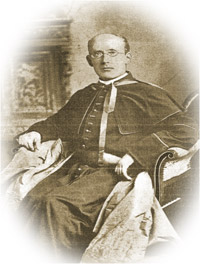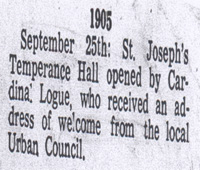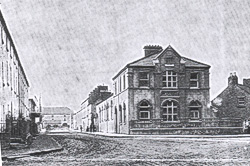History of the Temperance Hall
 Bishop Hoare
Bishop Hoare
The Temperance Movement was very prominent throughout Ireland in the late 19th century. One of its most enthusiastic supporters was Bishop Hoare of Ardagh and Clonmacnois. Among his many achievements on behalf of the town, the parish and the diocese, he built, largely out of his own resources, the splendid parochial hall known as St Joseph’s Temperance Hall. He intended it for “the recreation and instruction of the young men of the town”.
The contractors were Kelly and Sons, Earl Street and the total cost was over 3,000 pounds. It was officially opened by Cardinal Logue, Archbishop of Armagh, on the invitation of Bishop Hoare, on Monday 25th September 1905. The Cardinal had officiated at the consecration of the magnificent new Church of St Brigid in Ardagh on the previous day.
 Both events received extensive coverage in the Longford Leader. An extract from the report of the Longford ceremony reflects the public attitude to it: “Marking as it does the great advancement the holy cause of Temperance has made in the town and district of Longford during the past few years, and standing as an emblem of the complete and absolute revolution that has manifested itself in the minds and morals of the people, the new Temperance Hall is indeed a great requisition to Longford. Appreciating the extent of the honour conferred on Longford by the visit of Cardinal Logue, Archbishop of Armagh, His Eminence will be presented with addresses from the Urban Council and other bodies.
Both events received extensive coverage in the Longford Leader. An extract from the report of the Longford ceremony reflects the public attitude to it: “Marking as it does the great advancement the holy cause of Temperance has made in the town and district of Longford during the past few years, and standing as an emblem of the complete and absolute revolution that has manifested itself in the minds and morals of the people, the new Temperance Hall is indeed a great requisition to Longford. Appreciating the extent of the honour conferred on Longford by the visit of Cardinal Logue, Archbishop of Armagh, His Eminence will be presented with addresses from the Urban Council and other bodies.
 The Temperance Hall shortly after it was built
The Temperance Hall shortly after it was built
The ambitious dream of Bishop Hoare was that the Hall would be a place where the people of the town and parish would have a comfortable and commodious place to come together for recreation, reading and cultural activities in an alcohol free environment. That dream has been realised by the countless hours of enjoyment found there by succeeding generations, Bishop Hoare was a man ahead of his time because the Temperance Hall served as a prototype for other halls around the country and diocese when they came to be built many years later.
